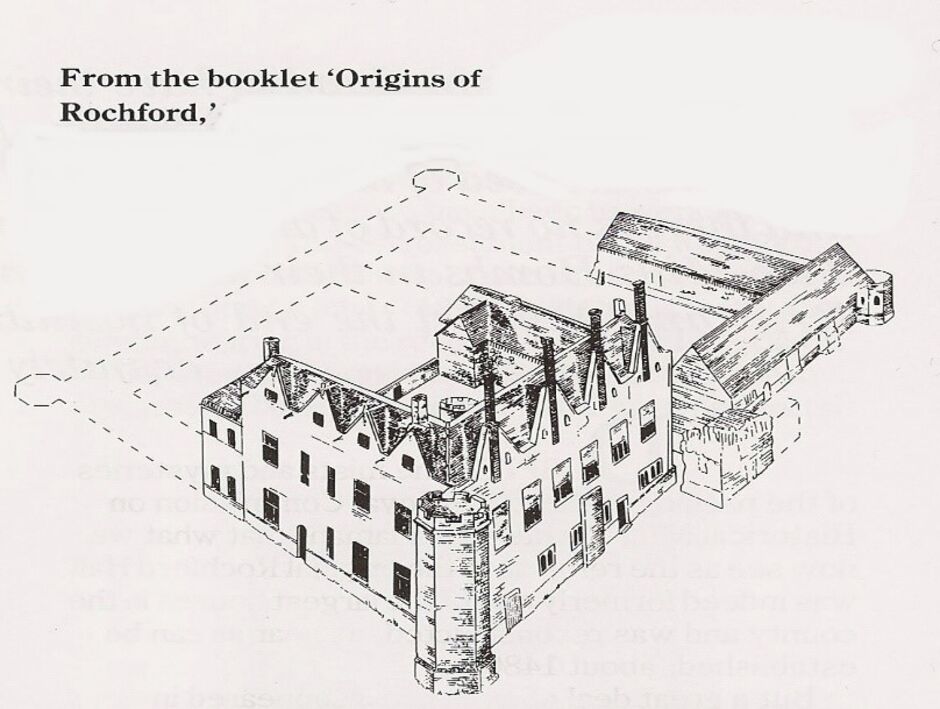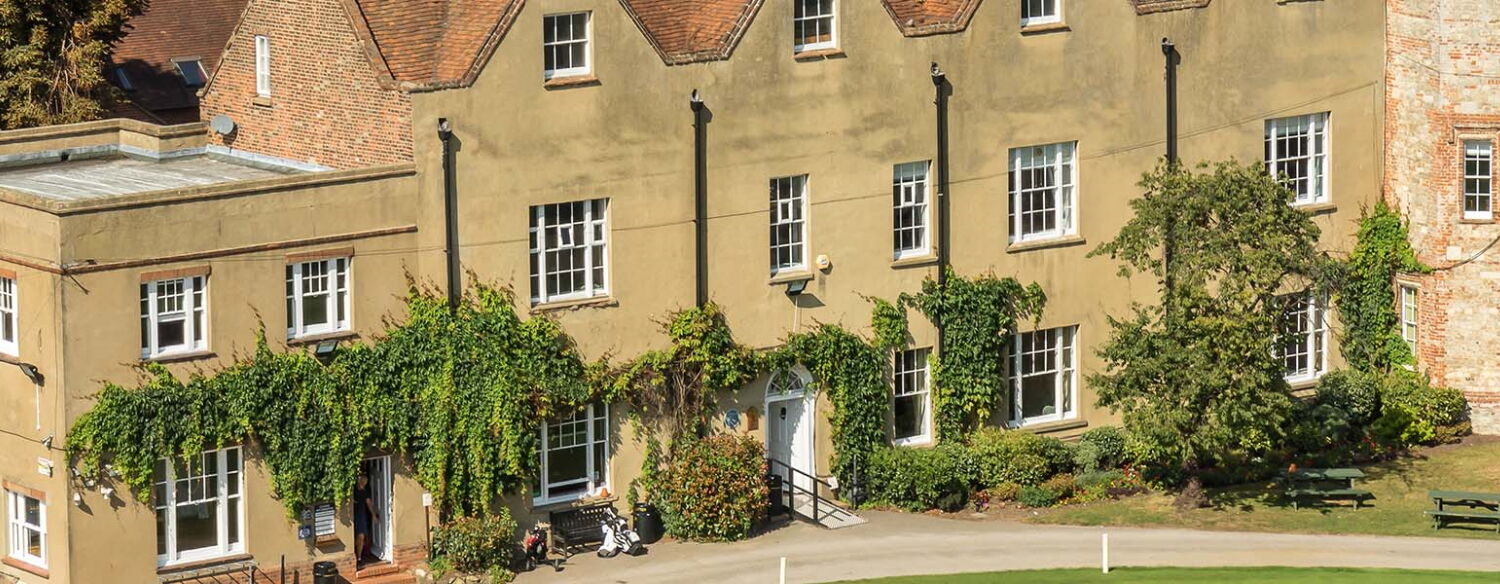Despite the mists and mysteries of passing time the Royal Commission on Historical Monuments was adamant that what we now see as the remains of the original Rochford Hall was indeed formerly one of the largest houses in the county and was reconstructed, as near as can be established, around 1480. But a great deal of evidence disappeared in smoke when the south section of the Hall was partly destroyed by a disastrous fire in 1760 and the rest of that area was demolished during the 19th century. What seems to be beyond doubt is that a manor house of grand scale has existed on the site since the time of The Great Survey in 1086, which ultimately became known as The Domesday Book.
It is likely that around 1455 the then owner James Boteler (Butler) , 5th Earl or Ormonde and 1st Earl of Wiltshire, demolished the existing stone manor house and commenced, probably in a modest manner, the mansion which was to be developed and extended by others into the magnificent edifice which eventually became Rochford Hall. We know from the Boteler arms which appear on the stones of the tower of St Andrews Church, adjacent to the Hall, that it was built by that family, possibly James, but more likely his younger brother Thomas. History tells us that in 1485 the estate passed to Thomas Boteler, the 7th Earl of Ormonde and a Member of Parliament in 1495, under the title of Thomas Ormonde de Rochford. Excavations have revealed that there had been a building on the site before de Rochford set about establishing his home, but he certainly made his own personal mark on the area.
Thomas Boteler died in 1515 and one of his two daughters, Margaret, who married Sir William Bullen (Boleyn) of Bickling Hall in Norfolk became the heiress to Rochford Hall. Although the family home was Hever Castle in Kent they were frequent visitors to Rochford Hall. Their eldest son Thomas inherited the title Viscount Rochford and in due course the estates that went with it. In due course Viscount Rochford fathered three children – George and two daughters Mary and Anne, who was later to become King Henry VIII’s second wife. Space on this page does not allow the unpicking of the relationship between Anne Boleyn and Henry VIII, which is in any event is examined elsewhere by experts. However, suffice it to say that Anne Boleyn’s failure to deliver the King a son and heir created the need for him to find a reason to rid himself of her. The outcome of which was that she found herself accused of adultery with assorted men including incest with her brother George. The rest as they say is history.
Upon the death of Thomas Boleyn (Lord Rochford and 2nd Earl of Wiltshire) ownership of Rochford Hall passed to Anne Boleyn's sister Mary, who in 1520 had married Sir William Carey and with whom in 1526 she had given birth to a son Henry. At about this time court rumour suggested that Mary was a mistress to King Henry VIII and it is likely that it was he, not William Carey, who was the boy's father. Mary died at Rochford Hall on 19th July 1543 leaving many properties in the Hundred, including the Hall, to her seventeen year old son.
When Henry Carey came of age in 1547, in addition to Rochford Hall and its associated lands, he inherited land in Hampshire, Wiltshire and Buckinghamshire, including the borough of Buckingham itself from whence he secured election as Member of Parliament in 1547 and again in 1554 and 1555. It may be that Carey took more interest in his estates to the west of London than he did of those in Essex as in about 1552 he parted with the Manor and estates of Rochford and sold them to Richard Rich.
Richard Rich (born c1496 in Basingstoke) practiced as a lawyer and had been acquiring land and property in Essex for over 25 years, so would have been pleased to add Rochford to his very considerable assets in the county. Sir Richard Rich, or Lord Rich of Leez as he became known was Member of Parliament for Colchester from 1529. He was the most machiavellian of characters who by continually shifting his political allegiances always came out on the winning side. In the 1966 film Man for All Seasons was portrayed by the actor John Hurt.
Rich was married to Elizabeth Jenks in 1518 and fathered six sons and ten daughters, as well as an illigitimate son and three daughters. The extent to which Richard Rich, with his massive wealth, added to Rochford Hall is not known, but the family wealth undoubtedly provided for the building work which took place at the end of the sixteenth and beginning of the seventeenth centuries and turned Rochford Hall into a grand residence. He died there on 11 June 1567 leaving the two principal Manors of Rochford Hall and Leighs (Leez) to his son and heir Robert. He is buried at Holy Cross Church in Felsted, Essex as are other members of his family.
When Sir Robert Rich inherited Rochford Hall he was 30 years of age and married to Elizabeth Baldry of Hadley in Suffolk. He was appointed a Knight of the Bath in 1558 at the coronation of Queen Elizabeth and eventually became Lieutenant for Essex. Unlike his father Robert Rich did not hold significant public office, or become involved in affairs of state. It would appear that he spent considerable time in Essex and was probably responsible for much of the late sixteenth century addition to Rochford Hall. Rich's eldest son Richard had died in 1580, so upon his death in February 1581 ownership of Rochford Hall passed to his second son, also named Robert (born December 1559), who three weeks earlier aged 22 had been returned at a by-election as Member of Parliament for Essex. For six generations between 1551 and 1678, when Mary Countess of Warwick died, Rochford Hall was in the ownership of direct descendants of Richard Rich.
In 1712 Rochford Hall was sold for only the second time in its long history the buyer being the thirty two year old Sir Richard Child. Sir Richard's father Sir Joshua Child was a most wealth man and the Child family had already accumulated considerable estates including some previously owned by the Rich family. In 1731 Sir Richard took the title of Earl Tylney and by Act of Parliament in 1734 his two sons took the name Tylney. Earl Tylney died in 1750 and as his eldest son Richard had predeceased him the title and estates passed to his second son John, about whom little is known beyond the fact that he was unmarried and a Fellow of The Royal Society.
It was during the second Earl's ownership in about 1760 that there was a great fire at Rochford Hall and the building was partly destroyed. No records were left of the damage, but the mansion was reduced to less than half its size. This resulted in much of the building to the south being pulled down. The north western corner was roofed over as barns and other parts to be left derelict only to be pulled down decades later when they became dangerous, or builders needed the stones. This diagram below right gives some idea what remained after the fire, but a conjectural painting by Norman Barnes now hanging in the Rochford Hundred clubhouse gives some appreciation of what Rochford Hall may have looked like in the sixteenth century throughout the period it was in the ownership of members of the Rich family.
When John the second Earl of Tylney died the estate passed to his sister's son Sir James Long, who then took the name Tylney-Long although the title died with the second Earl. Upon Sir James death in November 1794 his daughter Catherine, then aged sixteen became heiress to all the Essex, Hampshire and Wiltshire estates and was described as the wealthiest woman in England. Understandably she had many suitors seeking her hand in marriage including the Duke of Clarence (later to become King William IV), but she fell in love with William Pole-Wellesley, 4th Earl of Mornington and nephew of the Duke of Wellington. They married on 14th March 1812, in St James's Church, Piccadilly and William took the name Pole-Tylney-Long-Wellesley, which was a condition of the marriage. As can be seen from the link William Pole-Tylney-Long-Wellesley was an utter waster and upon his death in 1857 Rochford Hall was inherited by his eldest son William Richard, who it seems spent most of his time on the continent and had little concern for the estate. When he died in 1863 the landed property was left to his father's cousin Earl Cowley the then British ambassador in Paris. His ownership was short lived as he quickly transferred it to his son Viscount Dangan, who at the time was a twenty nine year old Lieutenant Colonel in the Coldstream Guards.
Viscount Dangan had little time to manage the Rochford estates and in 1867 put them up for sale by auction. So for only the third time in its history the estate went on the open market, and in August 1867 farmers from around Essex made the journey to London for the sale of Rochford Hall Farm. Among those showing an interest, attracted by the handbill reproduced below, was James Tabor.
James Tabor came from a farming family with its roots firmly set in Essex. He became a magistrate and was a leading person in the area. Successfully as a farmer he rented, or bought several farms in the Rochford neighbourhood and in the course of time farmed some 2000 acres. Around 1860 he became tenant farmer of Rochford Hall farm where he grazed both cattle and sheep. We are told that the Hall was scarecly fit for anyone to live in and it would have cost a very large sum of money to restore it properly, but the owners objected to it being left derelict. As a consequence he made one or two rooms habitable, although it seems he had the resources to restore Rochford Hall to something near its former grandeur.
At the auction in London James Tabor successfully bid for ownership of Rochford Hall farm, complete with "ancient Elizabethan residence", as well as a number of other agricultural lots in the area. And so it was that with this purchase James Tabor became only the forty-second Lord of the Manor of Rochford since the Domesday Book in 1086. Although he now owned Rochford Hall it never became his residence as he preferred to remain at Earls Hall farm, where he was never anything more than a tenant and was described by a sister as the grandest Tabor living in the worst house.
As has been described elsewhere in these chapters in 1896 James Tabor offered the land adjoining the Hall for the creation of a golf course together with part use of the building as a clubhouse. Although James died in 1888 his grandsons and great grandsons continued to accommodate the golf club until 1980 when Robert Tabor sold the golf course and the north east part of Hall which they occupied to Rochford Hundred Golf Club.
Robert Tabor died in 1985 aged 84 and his son Charles inherited Rochford Hall farm, but had no use for the old barns which prior to the fire of 1760 formed the North West part of Rochford Hall. In 1983 these were sold to Malcolm Ginns in order that they could be restored as Grade 1 Listed Buildings, to four residential properties. The Secretary of State made an order granting consent in December 1984 and this excellent restoration work was finally completed in December 1989.
Clubhouse History
Rochford Hundred Golf Club

Rochford "Hall" In The 16th Century

Origins Of Rochford








